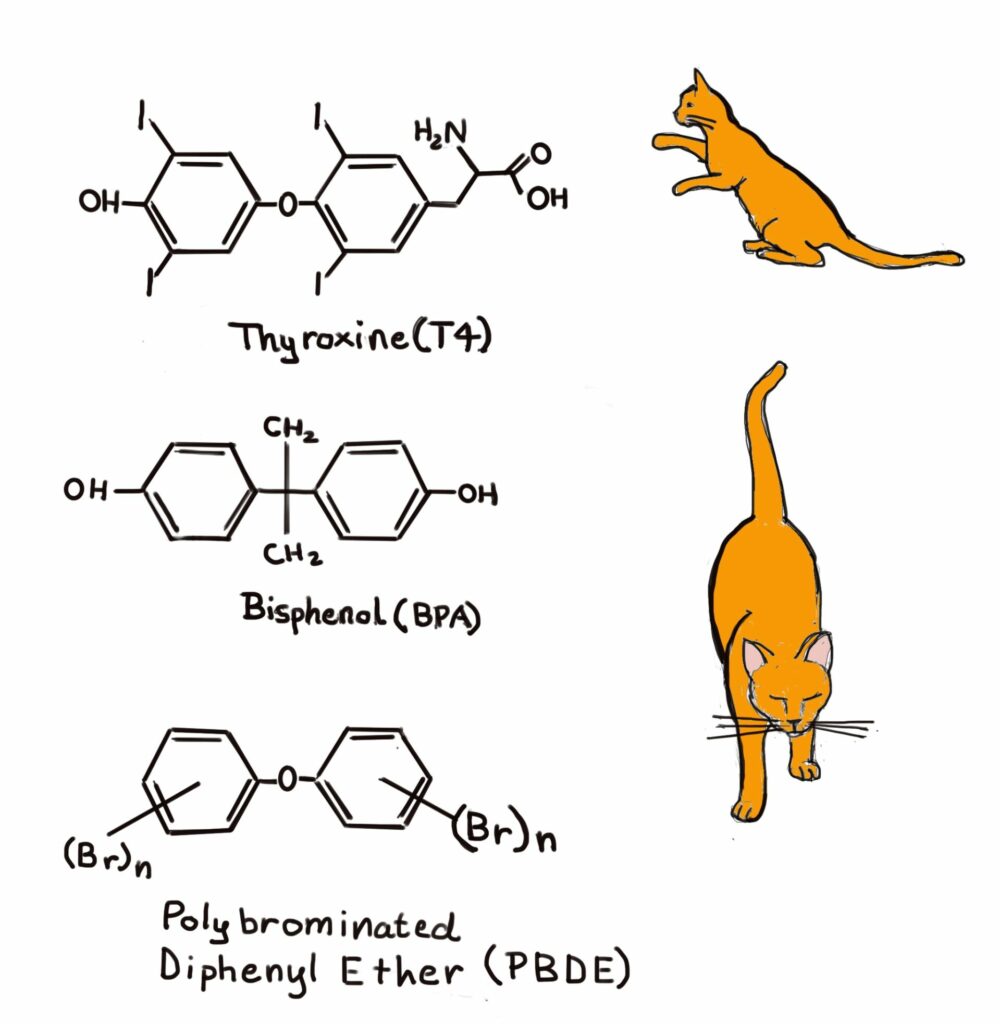
About 10% of senior cats will develop a condition called hyperthyroidism in their lives. Hyperthyroidism can affect a cat’s quality of life and potentially shorten it.
What is hyperthyroidism?
A cat has two thyroid glands, one on each side of the throat below the larynx or voice box. In a healthy cat, these glands are small and difficult to feel. In a cat with hyperthyroidism, these glands are enlarged due to an overgrowth of tissue. This tissue is functional and produces thyroid hormones. Chemical assay of an affected cat’s blood will show an excess of thyroxine (T4).
Most of these growths are benign – only 2% of hyperthyroid cats have cancerous tumors at the time of diagnosis (Reference 1).
Hyperthyroidism in Cats – what you may notice
- Weight loss
- Increase in vocalizing
- Hyperactivity
- Increased thirst and urination
- Unthrifty haircoat
- Vomiting
- Diarrhea
Hyperthyroidism in cats – causes?
Hyperthyroidism was rare in cats prior to 1970 – the first case was officially reported in 1979 (Reference 2). What has changed since the ’70’s?
- cats are living longer
- more cats are eating commercial cat food
- many cats live exclusively indoors
Longer Lifespan
Humans are more at risk to form small growths on their thyroid glands as they age (Reference 1). It is likely that older cats are also more predisposed to thyroid tumors.
Diet
Soy can be found in many cat foods, particularly dry formulations. Soy inhibits some of the key enzymes in the production of the thyroid hormones. The pituitary gland responds to the lower levels of thyroid hormones by producing TSH (thyroid stimulating hormone). More thyroid tissue grows to meet the need for thyroid hormones.
Studies with rats have linked eating soy with thyroid tumors, but only when consuming diets deficient in iodine (Reference 2). Could iodine supplementation help? More research is needed to determine how large a role iodine plays in feline hyperthyroidism. Most cats are exposed to other chemicals in their environment, drinking water, and diet that also affect thyroid function. How much do these chemicals contribute to the development of feline thyroid tumors?
Cat food can linings and Bisphenol A
Most canned cat foods have a plastic coating to extend the shelf life of the food inside and guard against contamination. Many of these canned linings contain a chemical called bisphenol A or BPA.
BPA has a chemical structure that is similar to the thyroid hormones and can possibly interfere with thyroid hormone function. (Even though most of the linings are PVC, BPA can be an additive in the processing of PVC). Although the FDA says the level of BPA in cans is very low and does not present health risks to humans, the agency did ban the use of BPA in baby bottles, sippy cups and infant formula packaging in July of 2012.
Hyperthyroidism in cats – the environment
Poly brominated diphenyl ethers (PBDE) are another class of compounds that have a chemical structure similar to the thyroid hormones and are known to disrupt thyroid metabolism. PBDE’s are used as flame retardants in electronics, furniture and textiles as well as construction materials (Reference 2).
In 2004, manufacturers in the US voluntarily stopped making many of the PDBE flame retardants. However, these chemicals accumulate in the environment and have been detected in significant amounts in animals as well as humans.
Multiple studies have found that house cats have serum levels of PBDE that are about 50 times higher than that in humans (Reference 2). A study at the University of Illinois found that feral cats had a lower level of PBDE’s in their blood than house cats. This indicates that house cats are exposed to PBDE in their homes.
Further work analyzed dust samples and found higher concentrations of PBDE’s in dust from the homes of hyperthyroid cats compared with those of healthy cats (Reference 2). As cats groom, they can ingest dust and possibly PBDE.
At this time, there are not any studies that have conclusively linked exposure to a specific chemical compound to hyperthyroidism in cats. Soy, iodine, BPA and PBDE’s may or may not play a significant role in cats becoming hyperthyroid (Reference 1).
Preventing Hyperthyroidism in cats
The suggestions below will certainly not hurt your cat and may limit his exposure to chemicals that can disrupt thyroid function (Reference 2).
- Avoid cat food products containing soy products.
- Limit fish-flavored foods: fish contain high levels of iodine and may be contaminated with PCB, PBDE, etc.
- Feed wet foods in foil pouches in preference to using canned food possibly lined with coatings containing BPA
- Home cooked diets can help help avoid contamination with chemicals but consult with a veterinary nutritionist so that the diet is balanced and complete.
- Use ceramic or glass containers for feeding and storage to reduce exposure to chemicals like BPA.
- Use filtered water from the tap to limit exposure to chemicals.
- Vacuum regularly to limit the dust your cat ingests.
- Avoid cat litters with deodorizers or odor neutralizers.
Thyroxine (T4) levels are routinely checked on most senior feline blood panels. Annual or bi-annual labwork will let you know if your cat is developing hyperthyroidism. This way, you can plan for appropriate treatment before your feline friend starts to show outward symptoms.
What are the treatment options for hyperthyroidism in cats? We will look at these in the next post.
references
- Carney HC, Ward CR, Bailey SJ, et al. 2016 AAFP Guidelines for the Management of Feline Hyperthyroidism. Journal of Feline Medicine and Surgery. 2016;18(5):400-416. doi:10.1177/1098612X16643252
- Peterson M. Hyperthyroidism in cats: what’s causing this epidemic of thyroid disease and can we prevent it? J Feline Med Surg. 2012 Nov;14(11):804-18. doi: 10.1177/1098612X12464462



1 thought on “Hyperthyroidism in Cats – What is it? Why Does It Happen?”